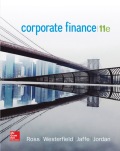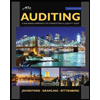
To determine: The difference between systematic risk and unsystematic risk.
Introduction:
Systematic risk is essential for the complete market or segment. It is otherwise called market risk or undiversifiable risk that has an overall impact. This risk is unavoidable and not predictable. Here, hedging and appropriate strategy of asset allocation works out. While, mitigation with diversification is not possible.
Systematic risk states how one investment supports to the total aggregate risk of business’s financial funding.
Unsystematic risk is otherwise called the diversifiable, residual, non-systematic or specific risk. The proportion of a corporation’s total or aggregate risk which can be reduced through diversified asset portfolio.
Explanation of Solution
The following are the differences between systematic risk and unsystematic risk:
- Systematic risks are type of risks that cannot be differentiated through the construction of a portfolio.
- Normally, systematic risk factors influence a substantial number of firms in the market, though those elements will not really influence all organizations similarly.
- Unsystematic risk can be diversified or reduced through portfolio development.
- Unsystematic risk issues are particular to the firm or industry.
- While, some components impact the profitability of an industry/firm; it does not in another firm/industry. However, it can be applicable for different firms in same industry.
Want to see more full solutions like this?
Chapter 12 Solutions
EBK CORPORATE FINANCE
- Pam and Jim are saving money for their two children who they plan to send to university.The eldest child will enter university in 5 years while the younger will enter in 7 years. Each child is expected spend four years at university. University fees are currently R20 000 per year and are expected to grow at 5% per year. These fees are paid at the beginning of each year.Pam and Jim currently have R40 000 in their savings and their plan is to save a fixed amount each year for the next 5 years. The first deposit taking place at the end of the current year and the last deposit at the date the first university fees are paid.Pam and Jim expect to earn 10% per year on their investments.What amount should they invest each year to meet the cost of their children’s university fees?arrow_forwardYou make a loan of R100 000, with annual payments being made at the end of each year for the next 5 years at a 10% interest rate. How much interest is paid in the second year?arrow_forwardDr Z. Mthembu is the owner of Mr Granite, a business in the Western Cape. After more than 28 years of operation, the business is thinking about taking on a new project that would provide a profitable new clientele. With only R1.5 million in resources, the company is now working on two competing projects. The starting costs for Project X and Project Y are R625,000 and R600000, respectively. These projected are estimated for the next 7 years timeframe. According to SARS, the tax rate is 28%, and a discount rate of 11.25% is applied.Projects X Project YProject X Project Y129000 145000154000 145000312000 145000168000 14500098250 14500088750 14500016050 145000arrow_forward
- Dr Z. Mthembu is the owner of Mr Granite, a business in the Western Cape. After more than 28 years of operation, the business is thinking about taking on a new project that would provide a profitable new clientele. With only R1.5 million in resources, the company is now working on two competing projects. The starting costs for Project X and Project Y are R625,000 and R600000, respectively. These projected are estimated for the next 7 years timeframe. According to SARS, the tax rate is 28%, and a discount rate of 11.25% is applied.Projects X Project YProject X Project Y129000 145000154000 145000312000 145000168000 14500098250 14500088750 14500016050 145000arrow_forwardDr Z. Mthembu is the owner of Mr Granite, a business in the Western Cape. After more than 28 years of operation, the business is thinking about taking on a new project that would provide a profitable new clientele. With only R1.5 million in resources, the company is now working on two competing projects. The starting costs for Project X and Project Y are R625,000 and R600000, respectively. These projected are estimated for the next 7 years timeframe. According to SARS, the tax rate is 28%, and a discount rate of 11.25% is applied.Projects X Project YProject X Project Y129000 145000154000 145000312000 145000168000 14500098250 14500088750 14500016050 145000arrow_forwardDr Z. Mthembu is the owner of Mr Granite, a business in the Western Cape. After more than 28 years of operation, the business is thinking about taking on a new project that would provide a profitable new clientele. With only R1.5 million in resources, the company is now working on two competing projects. The starting costs for Project X and Project Y are R625,000 and R600000, respectively. These projected are estimated for the next 7 years timeframe. According to SARS, the tax rate is 28%, and a discount rate of 11.25% is applied.Projects X Project YProject X Project Y129000 145000154000 145000312000 145000168000 14500098250 14500088750 14500016050 145000arrow_forward
- An investor buys 100 shares of a $40 stock that pays an annual cash dividend of $2 a share (a 5 percent dividend yield) and signs up for the DRIP. a. If neither the dividend nor the price changes, how many shares will the investor have at the end of 10 years? How much will the position in the stock be worth? Answer: 5.000 shares purchased in year 1 5.250 shares purchased in year 2 6.078 shares purchased in year 5 62.889 total shares purchased b. If the price of the stock rises by 6 percent annually but the dividend remains at $2 a share, how many shares are purchased each year for the next 10 years? How much is the total position worth at the end of 10 years? Answer: 4.717 shares purchased in year 1 4.592 shares in year 3 3.898 shares in year 10 Value of position: $10,280 c. If the price of the stock rises by 6 percent annually but the dividend rises by only 3 percent annually, how many shares are purchased each year for the next 10 years? How much is the total position worth at the…arrow_forwardDr Z. Mthembu is the owner of Mr Granite, a business in the Western Cape. After more than 28 years of operation, the business is thinking about taking on a new project that would provide a profitable new clientele. With only R1.5 million in resources, the company is now working on two competing projects. The starting costs for Project X and Project Y are R625,000 and R600000, respectively. These projected are estimated for the next 7 years timeframe. According to SARS, the tax rate is 28%, and a discount rate of 11.25% is applied.Projects X Project YProject X Project Y129000 145000154000 145000312000 145000168000 14500098250 14500088750 14500016050 145000 Calculate the IRR for the two proposed Projectsarrow_forwardYour sibling want to go on a holiday in 7 years. The cost of a similar holiday today is R70,000 and the cost of the holiday increases by 5% per annum.If he/she can earn 11% per annum on a savings account, how much must he/she save per month as from today to have the money ready in 7 years time? Note: savings will be at the beginning of each month.arrow_forward
- How does corporate governance of a not-for-profit business vary from corporate governance of a traditional for profit business?Include references.arrow_forwardGiven the information below for HooYah! Corporation, compute the expected share price at the end of 2026 using price ratio analysis. Assume that the histor (arithmetic) average growth rates will remain the same for 2026. end of Year 2020 2021 2022 2023 2024 2025 Price $ 27.00 $ 63.50 $ 135.00 $ 212.00 $ 102.00 $ 32.50 EPS -7.00 -6.29 -2.30 -0.57 0.05 0.06 CFPS -18.00 -15.50 -3.30 -0.05 0.63 0.08 SPS 24.00 32.50 27.60 31.10 34.60 40.95 What is the expected share price at the end of 2026, using PE ratio? $110.45 $100.45 $120.45 $90.45 22 Multiple Choice Given the information below for HooYah! Corporation, compute the expected share price at the end of 2026 using price ratio analysis. Assume that the histor (arithmetic) average growth rates will remain the same for 2026. end of Year 2020 2021 2022 2023 2024 2025 Price $ 27.00 $ 63.50 $ 135.00 $ 212.00 $ 102.00 $ 32.50 EPS -7.00 -6.29 -2.30 -0.57 0.05 0.06 CFPS -18.00 -15.50 -3.30 -0.05 0.63 0.08 SPS 24.00 32.50 27.60 31.10 34.60 40.95…arrow_forwardWhat is finance subject? how can this usefull with corporate finance?arrow_forward
 Intermediate Financial Management (MindTap Course...FinanceISBN:9781337395083Author:Eugene F. Brigham, Phillip R. DavesPublisher:Cengage Learning
Intermediate Financial Management (MindTap Course...FinanceISBN:9781337395083Author:Eugene F. Brigham, Phillip R. DavesPublisher:Cengage Learning EBK CONTEMPORARY FINANCIAL MANAGEMENTFinanceISBN:9781337514835Author:MOYERPublisher:CENGAGE LEARNING - CONSIGNMENT
EBK CONTEMPORARY FINANCIAL MANAGEMENTFinanceISBN:9781337514835Author:MOYERPublisher:CENGAGE LEARNING - CONSIGNMENT Auditing: A Risk Based-Approach to Conducting a Q...AccountingISBN:9781305080577Author:Karla M Johnstone, Audrey A. Gramling, Larry E. RittenbergPublisher:South-Western College Pub
Auditing: A Risk Based-Approach to Conducting a Q...AccountingISBN:9781305080577Author:Karla M Johnstone, Audrey A. Gramling, Larry E. RittenbergPublisher:South-Western College Pub- Business Its Legal Ethical & Global EnvironmentAccountingISBN:9781305224414Author:JENNINGSPublisher:Cengage
 Auditing: A Risk Based-Approach (MindTap Course L...AccountingISBN:9781337619455Author:Karla M Johnstone, Audrey A. Gramling, Larry E. RittenbergPublisher:Cengage Learning
Auditing: A Risk Based-Approach (MindTap Course L...AccountingISBN:9781337619455Author:Karla M Johnstone, Audrey A. Gramling, Larry E. RittenbergPublisher:Cengage Learning




